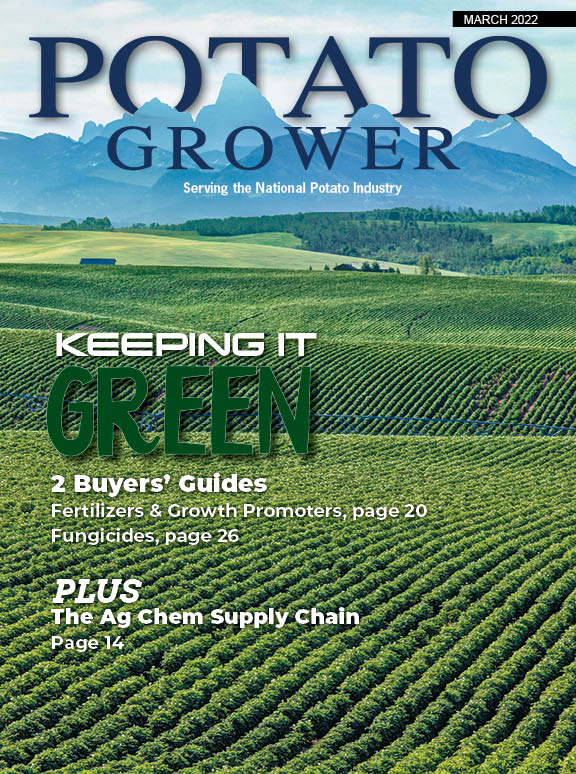Source: Growing Produce
During certain stretches of the growing season, potato growers must monitor the nitrogen status of their crop on a regular basis to fertilize in the most efficient and sustainable way possible.

A common practice is to collect petioles from numerous plants in each field, then send them for a nitrate analysis. Within a few days, growers receive results that indicate if more nitrogen fertilizer is needed. The system works, but it could be better, says Yi Wang, assistant professor and extension sustainable vegetable production specialist in the University of Wisconsin–Madison‘s Department of Horticulture.
“Collecting the petioles is time-consuming and labor-intensive,” Wang says. “And sometimes the results can be misleading because a lot of factors can affect petiole nitrate numbers, such as weather conditions or the time of day of sample collection. Plus, the results don’t catch spatial variation [of nitrogen needs] within the field.”
New Tool to the Rescue
To address these issues, Wang is leading an effort to develop a set of high-tech tools that give potato growers a potentially easier, faster, and more comprehensive way to assess the true nitrogen needs of their crops. The project, funded by USDA National Institute of Food and Agriculture, involves collecting and processing data from a hyperspectral camera. It’s mounted to a UAV (unmanned aerial vehicle) or low-flying airplane that flies over potato research plots grown at different nitrogen levels.
Wang’s team develops computer-assisted models to link the imagery with in-season plant nitrogen status and end-of-season yield, quality, and economic return. Ultimately, the project gives growers a tool to better manage nitrogen. “My collaborators and I hope to develop an online program that will translate the hyperspectral images into information about when to apply fertilizer and how much to apply, so that maximum profitability can be achieved for the growers with minimum environmental impacts,” Wang says.
How It Works
Hyperspectral cameras are powerful, detecting hundreds or thousands of spectral bands of sunlight reflected from the crop canopy, says Trevor Crosby, a graduate student in Wang’s laboratory. “Factors that cause variation in canopy health — such as nutrient status, water status, or disease pressures — are all related to the spectral reflectance and therefore can be visualized in the hyperspectral images,” he says.

One flight over a 70-by-150-meter research field can collect dozens of images, each with hundreds of spectral bands. To help expedite the image processing, Wang recruited two key collaborators. Phil Townsend, Professor, Department of Forest and Wildlife Ecology, is a national leader in remote sensing technologies. Paul Mitchell, Professor and Extension Specialist, Department of Agricultural and Applied Economics, performs economic analysis that informs the computer model’s nitrogen application recommendations.
“Dr. Townsend’s group has created a program that makes image processing really efficient,” says Wang. “We are very excited about plugging into that.”
Crosby, taking lead on collecting ground measurements, gathered data from field research plots at different potato growth stages. That included leaf area index, leaf and vine total nitrogen concentration, tuber set and individual tuber weight, and environmental factors such as soil moisture and temperature, solar radiation, and wind speed. At harvest, he measured total tuber yield and size profile.
Crosby then developed advanced models linking hyperspectral imagery with the ground measurements. The goal is to predict real-time crop nitrogen status and predict end-of-season tuber productivity and economic return. So far, the field work and image processing has been completed, and Crosby is focusing on model development.
“With all the issues in the state around nitrates in groundwater, we need to find ways to make better use of our fertility inputs, and we are hopeful that Yi’s new project can help direct those efforts,” says Andy Diercks, a fourth-generation potato grower at Coloma Farms, Inc. “The potential is significant. Yi’s new project represents an opportunity to really leap forward [in nitrogen management].”
Results Impact Growers
Wang shares the findings of her research efforts widely with the state’s potato and vegetable growers. She has good working relationships with farmers around the state, and many eagerly await her research findings and applications.
“Hyperspectral imaging has the potential to show the plant’s response to deficiencies in inputs before the human eye can see that response,” says Diercks. “If we can gain a few days in responding to nutrient stress, the impact to the health of the plants would be quite significant. Not to mention the possibility of using less inputs to remedy the situation —which would be a serious win-win.”


